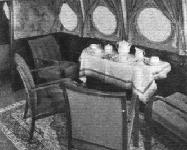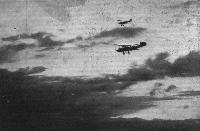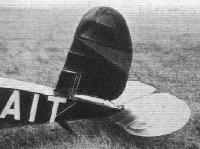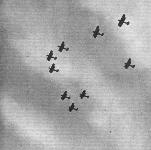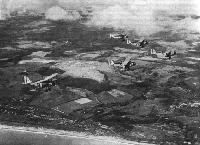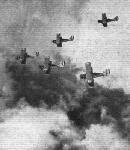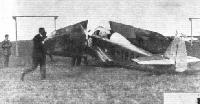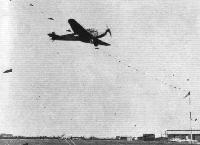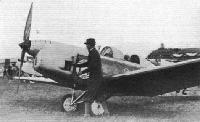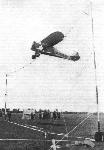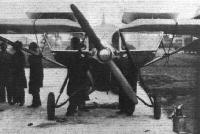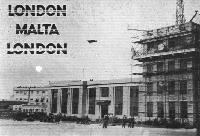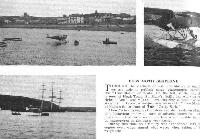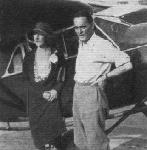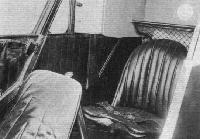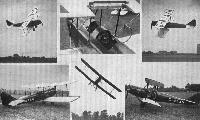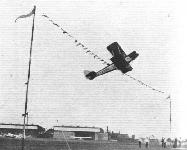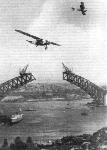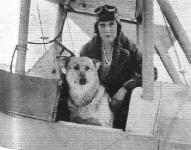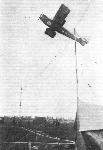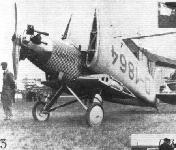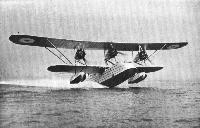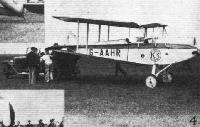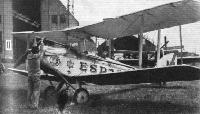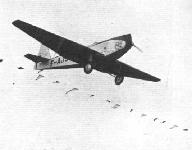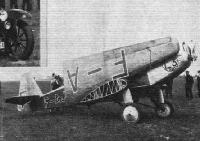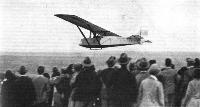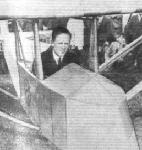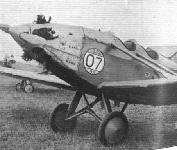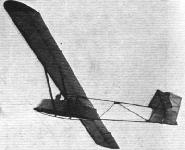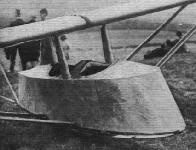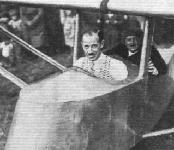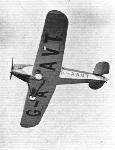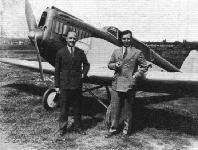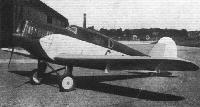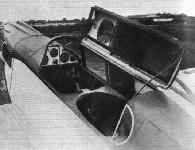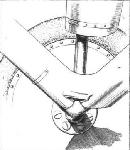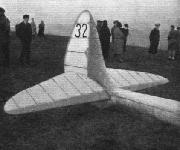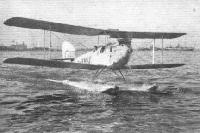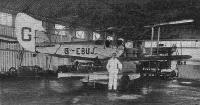Фотографии
-
Регистрационный номер: J8473 The three types of machines with which this Squadron is equipped, namely, on the left: the D.H.9, of which there are four; centre the Westland "Wapiti," which number eight, and finally - sundry Avro "Lynx" biplanes.
Самолёты на фотографии: Avro Avro 504N - Великобритания - 1920De Havilland D.H.9A - Великобритания - 1918Westland Wapiti - Великобритания - 1927
-
A Formation of "Bristol Fighters" of the O.U.A.S. Note the dark blue bands.
Самолёты на фотографии: Bristol F.2A/F.2B Fighter - Великобритания - 1916
-
Регистрационный номер: D-1929 THE Do. X. is now afloat again and has 12 Curtiss Conqueror type G.V. 15 per cent. 600 H.P. water-cooled engines installed. These are geared and mounted, as were the Jupiter engines, in six tandem nacelles.
Самолёты на фотографии: Dornier Do.X - Германия - 1929
-
Самолёты на фотографии: Dornier Do.X - Германия - 1929
-
One of the R.A.F. fighter flights half-way up a loop in formation.
Самолёты на фотографии: Armstrong Whitworth Siskin - Великобритания - 1921
-
Blue Siskins intercept a raid on Andover by Fairey III F.'s, but the bomb signal (the puff of smoke on the right of the picture) has been dropped.
Самолёты на фотографии: Armstrong Whitworth Siskin - Великобритания - 1921Fairey Fairey IIIF - Великобритания - 1926
-
No. 29 Fighter Squadron at Cranwell, waiting for raiders
Самолёты на фотографии: Armstrong Whitworth Siskin - Великобритания - 1921
-
Самолёты на фотографии: Armstrong Whitworth Argosy - Великобритания - 1926
-
The arrival at Croydon.
Самолёты на фотографии: Armstrong Whitworth Argosy - Великобритания - 1926
-
Регистрационный номер: G-AAAH AN ECHO OF A GREAT FLIGHT: A snap of Miss Amy Johnson taken at Sourabaya while her D.H. "Moth" was having its tanks replenished with "Shell" motor spirit.
Самолёты на фотографии: De Havilland Moth / D.H.60 - Великобритания - 1925
-
Регистрационный номер: J9187 Refuelling a Sidestrand.
Самолёты на фотографии: Boulton Paul Sidestrand / P.29 - Великобритания - 1926
-
A Flight of No. 23 Fighter Squadron catches the Sidestrands of No. 101 B.S. at Andover.
Самолёты на фотографии: Boulton Paul Sidestrand / P.29 - Великобритания - 1926Gloster Gamecock - Великобритания - 1925
-
Регистрационный номер: G-AAIT The unusual tail units of the Boulton & Paul Phoenix.
Самолёты на фотографии: Boulton Paul Phoenix / P.41 - Великобритания - 1929
-
No. 12 Bomber Squadron (Foxes) coming home to Andover from a raid.
Самолёты на фотографии: Fairey Fox - Великобритания - 1925
-
Five of the "Wapitis" of No. 601 (County of London) Bomber Squadron, A. A.F., led by Flight-Lieut. Whitehead Reid, M.B., flying along the coast near Folkestone. In the middle distance will be seen Shorncliffe Camp.
Самолёты на фотографии: Westland Wapiti - Великобритания - 1927
-
Another view of the "Wapitis" of 601 Squadron flying above the clouds.
Самолёты на фотографии: Westland Wapiti - Великобритания - 1927
-
A unique "aerial" of five "Wapitis" flying in formation above the clouds.
Самолёты на фотографии: Westland Wapiti - Великобритания - 1927
-
VARIOUS STYLES OF WING FOLDING: These photographs from the International Touring Competition indicate how aircraft designers of various nationalities provide for reducing space required for garaging machines. 1. a Klemm has its wings dismantled and stacked on the side.
Самолёты на фотографии: Klemm L.25 - L.28 Swallow - Германия - 1927
-
Poss, on a Klemm-Argus, clearing the obstacle.
Самолёты на фотографии: Klemm L.25 - L.28 Swallow - Германия - 1927
-
THE COFFEE MILL: Starting the Argus engine of a Klemm.
Самолёты на фотографии: Klemm L.25 - L.28 Swallow - Германия - 1927
-
Регистрационный номер: G-ABBR [2] Mr. Carberry (Mono Special-Warner) underestimates the run required during a practice take-off.
Самолёты на фотографии: Monocoupe 90 / 110 / 145 - США - 1930
-
Регистрационный номер: G-ABBR [2] Mr. Carberry (Mono-Special-Warner) in the take-off test.
Самолёты на фотографии: Monocoupe 90 / 110 / 145 - США - 1930
-
An unconventional view of a Puss-Moth. There is little doubt as to how it got its name if it is seen like this.
Самолёты на фотографии: De Havilland Puss Moth / D.H.80 - Великобритания - 1929
-
Регистрационный номер: G-ABBS A DE HAVILLAND "PUSS MOTH" FOR THE PRINCE OF WALES: This machine, recently finished, is painted in the Guards' colours - red and blue - and may be recognised from the identification letters G-ABBS.
Самолёты на фотографии: De Havilland Puss Moth / D.H.80 - Великобритания - 1929
-
CAPTAIN BARNARD'S RETURN. Note that the time is 14 minutes past six.
Самолёты на фотографии: De Havilland Puss Moth / D.H.80 - Великобритания - 1929
-
Регистрационный номер: G-AAXW Capt. C. D. Barnard and the D.H. "Puss Moth" on which he is attempting a flight from England to Malta in 14 hours.
Самолёты на фотографии: De Havilland Puss Moth / D.H.80 - Великобритания - 1929
-
THROUGH the kindness of Col. The Master of Sempill we are able to publish some photographs showing the "Puss Moth" on floats. On the left, at the top, she is seen at Hugh Town, St. Mary's, Scilly Is., while on the right, "Ann" and "Jane" are ensuring a clean "understanding"! Below, a unique view shows the "Puss Moth" at Falmouth, in front of the "Cutty Sark."
Самолёты на фотографии: De Havilland Puss Moth / D.H.80 - Великобритания - 1929
-
Home again: Captain Barnard and his wife after the completion of a very fine flight indeed.
Самолёты на фотографии: De Havilland Puss Moth / D.H.80 - Великобритания - 1929
-
THE END OF THE 2,800 MILES' FLIGHT: Barnard taxies his Puss Moth up to the Customs at Croydon.
Самолёты на фотографии: De Havilland Puss Moth / D.H.80 - Великобритания - 1929
-
Our photograph here shows the special interior fittings which have been incorporated in the Prince of Wales' new Puss Moth (Gipsy II). The cabin has a special finish and the rear seat has extra size and upholstery. This special seat can be removed and the normal one fitted when it is desired to use the third seat as well. Besides the seating arrangement the machine has an extra rear ventilator, dual control and a large luggage grid behind the rear seat.
Самолёты на фотографии: De Havilland Puss Moth / D.H.80 - Великобритания - 1929
-
Регистрационный номер: D-1895 An Albatros L.101 landing over the tape.
Самолёты на фотографии: Albatros L.101 - Германия - 1930
-
Регистрационный номер: D-1876 VARIOUS STYLES OF WING FOLDING: These photographs from the International Touring Competition indicate how aircraft designers of various nationalities provide for reducing space required for garaging machines. 5, is one of the Arado monoplanes, which uses a system intermediate between folding and stacking.
Самолёты на фотографии: Arado L.II - Германия - 1929
-
Регистрационный номер: G-AAXH A. SPORTS MODEL: The new Avian ("Hermes") provides for the private owner who wants something with a rather better performance than the ordinary light aeroplane offers. In the centre the well-shaped fairing and folding windscreens, can be seen, while the folding flap in the centre-section allows easy access to the rear cockpit.
Самолёты на фотографии: Avro Avian / Type 594/616 - Великобритания - 1926
-
Регистрационный номер: G-AAHJ Mr. Thorn (Avian Hermes) well over in the take-off test.
Самолёты на фотографии: Avro Avian / Type 594/616 - Великобритания - 1926
-
MISS JOHNSON AT SYDNEY: An "impression" of Miss Amy Johnson flying over the Sydney Harbour Bridge (under construction) in the National Airways Avro 10, on June 4
Самолёты на фотографии: Avro Ten / Type 618 - Великобритания - 1928
-
Самолёты на фотографии: De Havilland Hawk Moth / D.H.75 - Великобритания - 1928
-
Note the excellent view from the pilot's cockpit.
Самолёты на фотографии: De Havilland Hawk Moth / D.H.75 - Великобритания - 1928
-
A BLUEBIRD.PROJECT: Mrs Victor Bruce has just taken delivery of a Blackburn Bluebird (Gipsy II) and is spending most of ber time in the air at Brooklands, where she took her "A" licence.
Самолёты на фотографии: Blackburn Bluebird / L.1 - Великобритания - 1924
-
Регистрационный номер: G-AAJC A Bluebird (Gipsy I) which Capt. Roxborough Smith is flying for the Rhodesian Aviation Company. Flights over the Victoria Falls are very popular in this machine, especially for those on their first flight, as the side-by-side seating makes conversation easy.
Самолёты на фотографии: Blackburn Bluebird / L.1 - Великобритания - 1924
-
Регистрационный номер: N241 The Blackburn "Sydney." The largest military monoplane flying-boat. She has three Rolls-Royce F. XII M.S. engines, and has been designed for reconnaissance and coastal patrol work, carrying a normal crew of five - pilot, pilot-navigator, wireless operator, engineer and gunner.
Самолёты на фотографии: Blackburn Sydney / R.B.2 - Великобритания - 1930
-
Регистрационный номер: CF-AMI The Fairchild KR.21 (Genet Major) with a Townend Ring. A Canadian built private owner's machine.
Самолёты на фотографии: Kreider-Reisner C-4 / C-6 Challenger - США - 1928
-
Francis Lombardi (left) and his mechanic, Capannini, and the Fiat A.S.1 monoplane (95 h.p Fiat A.50) in which they flew from Vercelli to Tokio.
Самолёты на фотографии: FIAT AS.1 / AS.2 / TR.1 - Италия - 1928
-
Регистрационный номер: SP-ADA A BELIEVER IN CONTROL SURFACES: This Polish PWS 8 biplane, with Walter "Vega" engine, is very reminiscent of the Handley Page "Gugnunc." The lift bracing is in the form of a single strut in the plane of the rear spars.
PWS-8. First flown in the autumn of 1929 the PWS-8 was a two/three-seat sports and touring biplane, powered by an 85-h.p, Czech Waiter Vega five-cylinder air-cooled radial, permitting a cruising speed of 80 m.p.h. for a range of 435 miles. The PWS-8 was not built in large numbers, but one, SP-ADA (illustrated), took part in the 1930 European Challenge Cup and Competition, "Rundflug". The seating consisted of pilot and one passenger in the rear open cockpit, and the second passenger in the front cockpit. Behind the rear cockpit was a capacious luggage compartment. The colour scheme of SP-ADA was all-silver with red trim on wings and fuselage and black lettering and PWS trade mark on the fin. Span 32 ft. 9 1/2in. (upper), 29ft, 6 in. (lower); length 24ft. 8 in.; height 9 ft. 8in.Самолёты на фотографии: PWS PWS-8 - Польша - 1929
-
Регистрационный номер: G-AAWZ Mr. Andrews (Spartan-Arrow-Gipsy II) makes sure of clearing the take-off obstacle,
Самолёты на фотографии: Spartan Arrow - Великобритания - 1930
-
Регистрационный номер: D-1864 [2] Herr Johann Risztics (Junkers-Genet) watches his fuel being measured out after the consumption test.
Самолёты на фотографии: Junkers A 50 Junior - Германия - 1929
-
Регистрационный номер: D-1862 [2] A Junkers Junior, showing the new method of folding the wings.
Самолёты на фотографии: Junkers A 50 Junior - Германия - 1929
-
"GENETS" IN LOW-WING MONOPLANES: A Junkers "Junior"
Самолёты на фотографии: Junkers A 50 Junior - Германия - 1929
-
Регистрационный номер: D-1862 [2] VARIOUS STYLES OF WING FOLDING: These photographs from the International Touring Competition indicate how aircraft designers of various nationalities provide for reducing space required for garaging machines. 2, a Junkers "Junior" with a front spar universal joint.
Самолёты на фотографии: Junkers A 50 Junior - Германия - 1929
-
Регистрационный номер: D-1864 [2] VARIOUS STYLES OF WING FOLDING: These photographs from the International Touring Competition indicate how aircraft designers of various nationalities provide for reducing space required for garaging machines. 3. another Junkers uses stacking of the wings.
Самолёты на фотографии: Junkers A 50 Junior - Германия - 1929
-
A NEW FLYING BOAT FOR THE R.A.F.: The Supermarine-Jaguar "Southampton" Mark X has been built to the order of the Air Ministry at the Supermarine Works of Vickers (Aviation) Ltd. Note that the machine is about to take off on two engines only.
Самолёты на фотографии: Supermarine Southampton / Solent - Великобритания - 1925
-
"ON HER STEP": The Supermarine-Jaguar "Southampton" Mark X getting away. Note the clean running.
Самолёты на фотографии: Supermarine Southampton / Solent - Великобритания - 1925
-
THE VERVILLE TRAINER: A recent American machine produced by the Verville Aircraft Co. of Detroit.
Самолёты на фотографии: Verville Sportsman / PT-10 - США - 1930
-
Регистрационный номер: G-AALK Miss Spooner superintending the manhandling of her machine during the consumption trials.
Самолёты на фотографии: De Havilland Moth Coupe - Великобритания - 1928
-
Регистрационный номер: G-AAHR VARIOUS STYLES OF WING FOLDING: These photographs from the International Touring Competition indicate how aircraft designers of various nationalities provide for reducing space required for garaging machines. 4, shows the simple British way of folding, the machine being Broad's "Moth."
Самолёты на фотографии: De Havilland Moth Coupe - Великобритания - 1928
-
"OVER THE TAPE": Miss Spooner, in her Gipsy-Moth, clears the obstacle in the Technical Tests.
Самолёты на фотографии: De Havilland Gipsy Moth / Moth X - Великобритания - 1928
-
ENGINE-STARTING: Swinging the propeller of the Archduke Hapsburg-Bourbon's Gipsy-Moth.
Самолёты на фотографии: De Havilland Gipsy Moth / Moth X - Великобритания - 1928
-
M. Finat (Caudron-Renault) in the take-off test
Самолёты на фотографии: Caudron C.190 - Франция - 1929
-
VARIOUS STYLES OF WING FOLDING: These photographs from the International Touring Competition indicate how aircraft designers of various nationalities provide for reducing space required for garaging machines. 6, illustrates the Caudron way, tying the wings on with rope.
Самолёты на фотографии: Caudron C.190 - Франция - 1929
-
A Prufling of the London Gliding Club in the air over Ivinghoe Beacon.
Самолёты на фотографии: Lippisch / RRG Prufling - Германия - 1926
-
The Master of Sempill in a "Prufling."
Самолёты на фотографии: Lippisch / RRG Prufling - Германия - 1926
-
The machine park at Mousehold with the Avro Monoplane in the foreground.
Самолёты на фотографии: Avro Avian Monoplane / Type 625 - Великобритания - 1930
-
"GENETS" IN LOW-WING MONOPLANES: A PWS 51 (Polish) Machine.
Самолёты на фотографии: PWS PWS-51 - Польша - 1930
-
The Poppenhausen. A two-seater glider at Ivinghoe Beacon.
Самолёты на фотографии: Schleicher Poppenhausen - Германия - 1928
-
THE POPPENHAUSEN: A two-seater glider now in operation by the London Gliding club.
Самолёты на фотографии: Schleicher Poppenhausen - Германия - 1928
-
The cockpits of the Poppenhausen, taken at a recent meeting of the London Gliding Club.
Самолёты на фотографии: Schleicher Poppenhausen - Германия - 1928
-
Capt. Needham and Mr. Hembrow in the "Poppenhausen."
Самолёты на фотографии: Schleicher Poppenhausen - Германия - 1928
-
The Alert assembled.
Самолёты на фотографии: Abbott Farnham Alert - Великобритания - 1930
-
The Alert in its travelling crate
Самолёты на фотографии: Abbott Farnham Alert - Великобритания - 1930
-
Регистрационный номер: X397N, NR397N The new Burnelli "UB-20" air transport in flight. It has an aerofoil-section fuselage accommodating 20 passengers, and is equipped with two 800-h.p. Packard engines, and Goodyear "air wheels."
Самолёты на фотографии: Burnelli UB-20 - США - 1930
-
Регистрационный номер: G-AAVT [9] THE "HENDY" 302: Flying Views from below and above
Самолёты на фотографии: Hendy Hendy 302 - Великобритания - 1929
-
Регистрационный номер: G-AAVT [9] Самолёты на фотографии: Hendy Hendy 302 - Великобритания - 1929
-
Регистрационный номер: G-AAVT [9] THE "HENDY" 302: The mounting of the "Hermes" engine is very simple, and the attachment to fuselage corners is by stirrup plates.
Самолёты на фотографии: Hendy Hendy 302 - Великобритания - 1929
-
Регистрационный номер: G-AAVT [9] THE "HENDY" 302 Details of the wing construction. Note the lattice type drag bracing of the main spars.
Самолёты на фотографии: Hendy Hendy 302 - Великобритания - 1929
-
Регистрационный номер: G-AAVT [9] This view from below shows the neat way in which the centre-section of the wing fairs into the fuselage.
Самолёты на фотографии: Hendy Hendy 302 - Великобритания - 1929
-
Регистрационный номер: G-AAVT [9] HENDY MEN: On the left, Capt. E. W. Percival, and on the right, Mr. Basil B. Henderson.
Самолёты на фотографии: Hendy Hendy 302 - Великобритания - 1929
-
Регистрационный номер: G-AAVT [9] THE BUSINESS END: The cowling of the "Hermes"engine in the "Hendy" 302 has been carefully designed and although totally enclosed, the engine keeps remarkably cool.
Самолёты на фотографии: Hendy Hendy 302 - Великобритания - 1929
-
Регистрационный номер: G-AAVT [9] Первоначально Hendy 302 оснащался двигателем Cirrus Hermes I мощностью 105 л. с. (78 кВт), но затем последний заменили на Cirrus Hermes IV мощностью 130 л. с. (97 кВт), а также перепроектировали кабину и установили шасси с обтекателями колес. Модифицированная машина стала называться Hendy 302A.
DESIGNED by Mr. Basil B. Henderson, this new machine has been but recently produced, and is something of a "dark horse." Last year Mr. Henderson produced the "Hobo," incorporating a novel form of wing construction, and the "302" is a development of the smaller machine, being a cabin two-seater. As the picture shows, it is a low-wing monoplane. The occupants are placed in tandem. The engine is a Cirrus-Hermes.Самолёты на фотографии: Hendy Hendy 302 - Великобритания - 1929
-
Регистрационный номер: G-AAVT [9] THE CABIN OF THE "HENDY" 302: This is very comfortable, with plenty of leg and elbow room. The view is good, much better than one would expect from the external appearance.
Самолёты на фотографии: Hendy Hendy 302 - Великобритания - 1929
-
Provision is made, on the "Hendy" 302 for the support of a jack under the axle.
Самолёты на фотографии: Hendy Hendy 302 - Великобритания - 1929
-
THE "HENDY" 302: Mr. Henderson has designed a novel form of main spar bracing, in which the spars are braced top and bottom by lattice strips, anchored at their ends and points of intersection to three-ply gussets.
Самолёты на фотографии: Hendy Hendy 302 - Великобритания - 1929
-
Hendy 302 Cirrus "Hermes" Engine
Самолёты на фотографии: Hendy Hendy 302 - Великобритания - 1929
-
The Fafnir in the air, flown by Herr Groenhoff just after taking off at the Wasserkuppe
Самолёты на фотографии: Lippisch / RRG Fafnir - Германия - 1930
-
The "Fafnir," an interesting new glider built by the Rhon-Rossitten Gesellschaft, in flight at the Wasserkuppe during the competitions now in progress. The bird-like wings and the extraordinarily high aspect ratio should be noted. Extreme care has been taken in fairing the fuselage, and the pilot sits in a modified form of cabin, a centre fairing going right over his head and merging into the centre of the wing.
Самолёты на фотографии: Lippisch / RRG Fafnir - Германия - 1930
-
The tail units of the Fafnir, which has been designed by Herr Lippisch to replace the Wien.
Самолёты на фотографии: Lippisch / RRG Fafnir - Германия - 1930
-
A Singapore Club aircraft in its native element.
Самолёты на фотографии: De Havilland Moth Seaplane - Великобритания - 1926
-
The pleasant foreshore of the Singapore Club.
Самолёты на фотографии: De Havilland Moth Seaplane - Великобритания - 1926
-
Регистрационный номер: G-EBUJ The Club aircraft in their hangar.
Самолёты на фотографии: De Havilland Moth Seaplane - Великобритания - 1926
Статьи
- Flight



